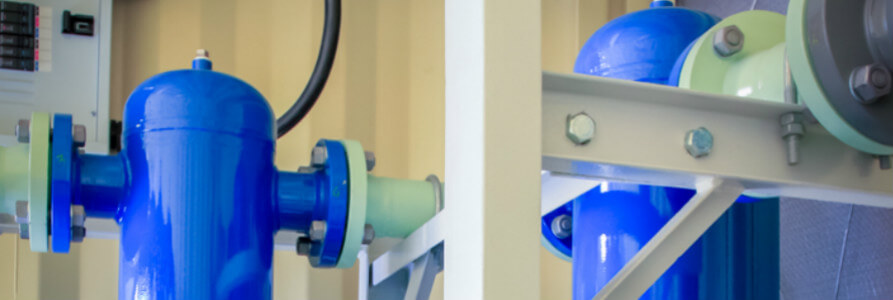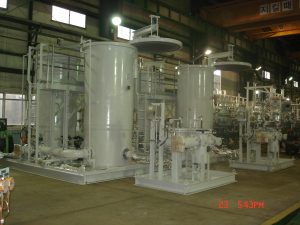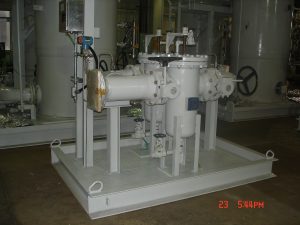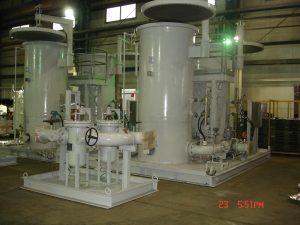Fuel Gas Conditioning
How Does a Coalescer Work & What is a Coalescing Filter?
July 31, 2024 Welcome

In downstream oil and gas operations, the separation of various crude fractions is crucial for purification and commercialization. This process involves removing multiple liquids and gases from the hydrocarbon mix in separation units, including gas-oil, fuel-gas, and water-gas separation. A vital piece of equipment used in this process is the coalescer.
What is a Coalescer?
A coalescer is a piece of industrial equipment used in the oil and gas processing and petrochemical industries to perform coalescence. Coalescence is the process of causing an agglomeration (coming together) of liquid aerosols to form larger droplets, which are then large enough to be drained away gravitationally. A coalescer operates in reverse to an emulsifier, which creates emulsions.
Coalescers can be used on their own or as a component of a larger filtration system. The selection of the appropriate coalescer type depends on the nature of the substance to be separated. For example, an oil coalescer or fuel coalescer can recover oil or fuel from a water-oil mix, respectively, while a gas coalescer separates gases from gas-fuel or gas-water emulsions.
Industrial Applications of Coalescers
Coalescers are widely used in downstream oil and gas operations and petrochemical industries for liquid-liquid or liquid-gas separation during product refining processes. For instance, liquid-gas coalescers are used in the downstream sector to separate water vapor and liquid hydrocarbons from natural gas streams, ensuring high product purity. This separation is essential for maintaining the quality and efficiency of the refining process.
In addition to purity concerns, coalescers play a vital role in protecting refining equipment from corrosion. By removing water and other contaminants, coalescers help extend the life of equipment and reduce maintenance costs. In the petrochemical industry, coalescers are part of particulate filtration systems to eliminate water vapor from products before storage, ensuring product stability and safety.
Types of Coalescers
There are two primary types of coalescers used in the industry, based on their mode of operation: electrostatic and mechanical coalescers. The mechanical coalescer is the predominant type utilized in the oil and gas industry and petrochemical plants worldwide.
Electrostatic Coalescers
Electrostatic coalescers use electric charges (DC or AC, or a combination of both) to induce coalescence of liquid molecules onto the surface of a collection tank. These coalescers are particularly useful in separating water-hydrocarbon emulsions and are widely used in offshore production platforms. The electrostatic charges help destabilize the emulsion by increasing the size of the molecules, causing them to fall to the bottom of the tank. This method is highly efficient in situations where the emulsion stability is due to the small size of dispersed droplets.
Mechanical Coalescers
Mechanical coalescers utilize a series of baffle walls or coalescing filters to separate water/hydrocarbon condensate from emulsions and coalesce them into larger molecules. A common application is the separation of water from liquid hydrocarbons or natural gas. Mechanical coalescers are highly versatile and can be designed to handle various flow rates and contamination levels. They are a preferred choice in many industrial applications due to their robustness and reliability.
How Does a Coalescer Work?
The functioning of a coalescer typically involves a series of separation mechanisms. The system is designed such that the separation devices trap the various components of the mixture at intervals. In a typical setup, the mixture enters the coalescer, where it encounters a series of baffle walls or filter elements. These elements facilitate the separation of the heavier or denser component (such as oil in a water-oil mix) from the lighter one (such as water). The denser component coalesces into larger droplets, which are then separated and removed from the system, often by gravitational settling or other mechanical means.
For example, in water-oil separation, baffle fibers separate the denser oil molecules and allow water molecules to diffuse and coalesce at a collection point beneath the baffle walls. The collected water can then be drained away mechanically. This process is efficient in ensuring that the separated water and oil are as pure as possible, minimizing the need for further treatment.
What is a Coalescing Filter?
A coalescing filter is a device used to separate vapors, liquids, soluble particles, or oil from another fluid through a coalescing effect. The coalescing effect refers to the coming together of liquid aerosols to form a larger whole, which is easier to filter out of the system due to increased weight. Coalescing filters are crucial in various applications, from natural gas purification to fuel refining, ensuring that the final product meets quality and safety standards.
The coalescing filter consists of several progressive layers which perform specific functions; from separating solid particles to liquid molecules from a gas flow. Some common materials used as coalescing filters include borosilicate microfibers and semi-permeable membranes. A coalescing filter for natural gas separates water vapor and other particulates to improve product purity.

Oil and gas skid manufacturers like IFS offer a range of cost-effective separation systems to the downstream oil and gas and petrochemical industries.
How Does a Coalescing Filter Work?
The separation of emulsions using a coalescing filter generally involves the following steps:
- Initial Filtration: The product is passed through a pre-filter to remove large solid particles and debris that could clog the coalescing filter elements.
- Coalescing Action: The fluid then passes through the coalescing filter elements, where fine droplets of liquid are trapped and merge together to form larger droplets.
- Separation: The larger droplets, being heavier, separate from the main fluid stream and are collected in a sump or drained away mechanically.
- Final Filtration: The remaining fluid may pass through a final coalescing filter to ensure the removal of any remaining fine particles or droplets, achieving the desired purity level.
The efficiency of coalescence (and the purity of the resulting fluid) is dependent on the quality of the coalescing media.
Innovations in Coalescing Technology
As the demand for higher efficiency and purity in oil and gas operations grows, advancements in coalescing filter technology continue to emerge. Some notable innovations include:
- Advanced Materials: Development of new coalescing media materials, such as nanofiber technology, improves separation efficiency and durability in coalescing filters.
- Automated Systems: Integration of smart sensors and control systems enhances the automation and monitoring of coalescing units, allowing for real-time adjustments and optimization within the filtration system.
- Compact Designs: Modern coalescers, including coalescing filter elements, are designed to be more compact and modular, making them easier to integrate into existing compressed air systems and reducing installation space requirements.
- Environmental Considerations: Innovations in coalescer design focus on reducing environmental impact by improving the efficiency of separation and minimizing waste generation.
Effective & Reliable Product Separation with IFS
If you need equipment, expertise, or consultancy services for your product filtration, look no further than IFS! Integrated Flow Solutions specializes in designing and fabricating modular, engineered-to-order process systems for the oil and gas industry. We offer a range of modular fluid filtration systems and fuel gas conditioning systems to meet the most stringent requirements for product purity.
All coalescing filter equipment is performance-engineered and quality-assured to meet international standards for quality and reliability. We also offer a team of experts for consultancy services for your organization, helping you select the best solutions for your specific needs and challenges.
Contact IFS/DXP Today!
For more information about our services and coalescing filter offerings, please contact us. At IFS/DXP, we are committed to providing innovative and reliable solutions to meet the evolving needs of the oil and gas industry. Whether you are looking to improve the efficiency of your existing operations or need new coalescing filters and equipment, our team is here to help.



